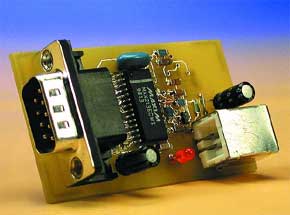Article
USB-RS232 Interface
A compact solution for missing ports

Thanks to a special integrated circuit from FTDI Chip, computer peripherals with an RS232 interface are easily connected to a USB port. This simple solution is ideal if a peripheral does not have a USB port, your notebook PC has no free RS232 port available, or none at all!After a slow and faltering start, the USB port has become commonplace on PCs, to the extent that the latest GHz machines have just one RS232 port left, or none at all. The compact USB-RS232 interface described in this article allows your good old RS232 peripherals (printer, programmer system, etc.) to be hooked up to a USB port. The free driver programs for Win98/ME/2000/XP, Linux and Apple Macintosh make the interface virtually transparent, enabling the USB port to behave like a regular COM interface.
Materials
Gerber file
CAM/CAD data for the PCB referred to in this article is available as a Gerber file. Elektor GREEN and GOLD members can exclusively download these files for free as part of their membership. Gerber files allow a PCB to be produced on an appropriate device available locally, or through an online PCB manufacturing service.
Elektor recommends the Elektor PCB Service service from its business partner Eurocircuits or AISLER as the best services for its own prototypes and volume production.
The use of our Gerber files is provided under a modified Creative Commons license. Creative Commons offers authors, scientists, educators and other creatives the freedom to handle their copyright in a more free way without losing their ownership.
PCB
Extra info / Update
In the circuit diagram on page 62, the value of R10 should be amended to read: 100 kOhm. This does not affect the Components List or the PCB layout.
Component list
All resistors and capacitors SMD shape 1206
Resistors:
R1,R3,R10 = 100k?
R2 = 470k?
R4,R5 = 10?
R6 = 1k?5
R7,R8 = 1k?
R9 = 10k?
R11 = 470?
R12 = 2k?2
Capacitors:
C1,C3 = 10nF
C2 = 33nF
C4,C5,C6,C8-C13 = 100nF
C7,C14 = 10µF 16V radial
Inductors:
L1 = BLM31A601S (Murata) (e.g., Farnell # 581-094)
Semiconductors:
D1,D2 = LED, 3mm dia.
T1 = BC857
IC1 = FT232AM or FT232BM (FTDI Chip order code FT8U232AM)
IC2 = 93C46 (optional)
IC3 = MAX213ECWI
Miscellaneous:
K1 = 9-way sub-D plug (male), PCB mount, angled pins
K2 = USB connector, type B, PCB mount
X1 = 6MHz ceramic resonator
Resistors:
R1,R3,R10 = 100k?
R2 = 470k?
R4,R5 = 10?
R6 = 1k?5
R7,R8 = 1k?
R9 = 10k?
R11 = 470?
R12 = 2k?2
Capacitors:
C1,C3 = 10nF
C2 = 33nF
C4,C5,C6,C8-C13 = 100nF
C7,C14 = 10µF 16V radial
Inductors:
L1 = BLM31A601S (Murata) (e.g., Farnell # 581-094)
Semiconductors:
D1,D2 = LED, 3mm dia.
T1 = BC857
IC1 = FT232AM or FT232BM (FTDI Chip order code FT8U232AM)
IC2 = 93C46 (optional)
IC3 = MAX213ECWI
Miscellaneous:
K1 = 9-way sub-D plug (male), PCB mount, angled pins
K2 = USB connector, type B, PCB mount
X1 = 6MHz ceramic resonator


Discussion (0 comments)